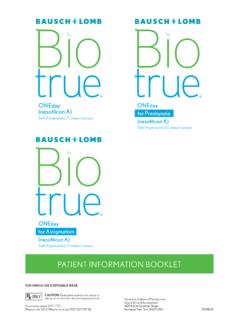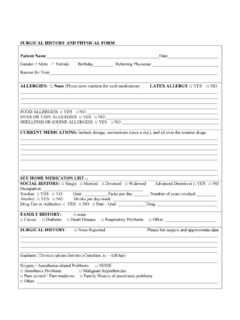Transcription of OPTICAL ABBREVIATIONS & GLOSSARY
1 OPTICAL ABBREVIATIONS & GLOSSARYOPTICAL ABBREVIATIONS20/20best vision approximate prism diopter degree of prism<less than>greater than increase decrease female malecombined with infinity+plus-minus A horizontal box measurementaapplanation tensionacbefore mealsacc accommodationADDadd power (multifocal)ARanti-reflective coating axaxis B vertical box measurementbblbarrel of hingeBCbase curveBDbase down prismBIbase in prismbifbifocalbidtwice dailyBObase out prismBOCdistance between OPTICAL center and top of segmentBUbase up prismBVPback vertex distancecwidth cccubic centimetercccomfort cable templeccwith correctioncf count fingersclcontact lenscmcentimeterCR-39plastic lens materialconvconvergentCRPC orneal reflection pupilometercylcylinderDdiopterDPdistance portion of lensDBLdistance between lenses (bridge)DBCdistance between centersdivdivergent DxdiagnosisECPeyecare professionalEDeffective diametereomextraocular movementsesotendency to turn inexo tendency to turn outwardexamexaminationetesotropiaETedge thicknessfbforeign bodyFDC frame distance centerFPfar pointFtflat top bifocalGCgeometric centergttsdropsHDhorizontal decentration of OPTICAL centerhgtheightHIhi-index lens materialhmhand motionhorizhorizontalhsat bedtimehyperuphypodownhxhistoryicbetween mealsIOPintraocular pressureIOL intraocular lensIPDinterpupillary distanceLleftliblibrary templelplight perceptionmmetermcmechanical centerMDPmonocular pupillary distancemmmillimeterMRPmajor reference pointnindex of refractionNegnegative__()
2 Nlpno light perceptionnnnanometernpnear pointnrpnear reference pointnvnear visionNvanear visual acuityOCoptical centerODoculus dexter - right of OptometryOLoverall lengthOPCoptical product codeOphtophthalmic-pertaining to the eyesOrthostraightOSoculus sinister - left eyeOUoculus uniter - both eyesozoptical zonePALprogressive addition lensPcafter mealsPDpapillary distancephpinholePlplanopoper os - orallyprnas neededPRPprism reference pointqdevery dayqid4 times a dayq2hevery 2 hoursqhevery hourqodevery other dayRrightRefrefractionRxprescriptionswit houtscwithout correctionsegsegmentseg htsegment heightSIsegment insertskskullSphsphereSOPstandard operating procedureSRCscratch resistant coatingStat at onceSVsingle visionSxsymptoms ttensiontemptemporal toward the templetid3 times a daytritrifocalUVultravioletvNu value, ABBE valueVAvisual analysis (eye examination)VDvertical decentration of OPTICAL centervertverticalvfvisual fieldWNLwithin normal limitsxaxisxpexophoriaxtexotropiazylplas tic frame material__GLOSSARY20/20 The expression for normal eyesight (6/6 in metric measurements).
3 Expressed as a fraction, the numerator refers to the distance the patient is from the test chart the standard distance is 20 feet (6 meters). The denominator denotes the distance at which a person with normal eyesight could read the same line. For example, if the patient s visual acuity is 20/100 then the smallest line they correctly read at 20 feet could be read by a person with normal vision at 100 feet. The Snellen chart consisting of letters, numbers, or symbols is used to test visual acuity or the sharpness of eyesight. A refraction test is used to determine the amount of correction needed for a prescription when treating refractive error such as astigmatism, myopia, or A Box Measurement The longest horizontal measurement of a lens; from the furthest nasal point to the furthest temporal point of a Value A measure of the degree to which light is dispersed when entering a lens.
4 The average range is 20 to 60. A lower Abbe value causes greater dispersion of light resulting in chromatic aberration (color fringing) when viewed through the periphery of the lens. A higher Abbe value results in less chromatic aberration. Abduction Outward movement of the eye Any flaw introduced during the manufacturing or grinding of a spectacle lens that can result in image blur. It may be inherent in the lens design or may result from an error in A substance used in friction process, such as grinding or Occurs when light is not reflected, refracted, or transmitted. The light energy is transformed into another form, such as Lens The ability of a lens to intercept or block general or specific wavelengths of radiant energy. Designed to provide eye comfort against Ratio Accommodative convergence/ accommodative (measured in prism diopters/diopters). The convergence response of an individual (amount the eyes turn inward) in relation to the amount of stimulus of accommodation (eye focusing).
5 The normal ratio is 4 The eye s focusing power enabling the eye to see clearly at different distances. This process is achieved by the lens of the eye changing its shape. Without the ability to accommodate, the image of an object would blur. Accommodative Vergence A convergence response (to turn the eyes inward) which occurs as a direct result of accommodation (eye focusing).Achromatism- The ability of the eye to adjust the focal power to see objects at different The ability to respond to faint sense impressions or to distinguish light differences between stimuli. Adaptation/Adaptive process The maneuvers (conscious or unconscious, automatic or voluntary) by which the individual attempts to make organismic decisions as comfortable and gratifying as possible within the demands of that individual s Power (addition) The difference in spherical power between the distance and near corrections found in bifocals, trifocals, and progressive addition lenses to assist the eye s accommodation at a given distance.
6 This power is needed for near vision. Also referred to as add power or seg power. Addition The OPTICAL power (of a lens) required for near vision, in addition to that required for far Inward movement of the eye Nose Pads Type of bridge that consists of small pads made of plastic or silicone to help prevent slippage and aid in evenly distributing weight of glasses on bridge of the Phenomenon Ability of the eye to retain sight of an image during eye blinks. The most common example is seeing light after the flash of a camera. Afferent Fibers Nerve fibers which carry impulses from the organs to the nerve centers. Against Motion Objects sighted through convex (plus) lenses move in an opposite (against) direction as the convex lenses are moved from side to Tempering The strengthening of a lens as a result of cooling a heated lens. Albinism Pigmentation is deficient or absent.
7 May occur in skin, hair, and eyes. Ocular albinism is a pigmentation deficiency occurring mainly in the eyes. Individuals with albinism including ocular albinism commonly have decreased visual acuity (20/70 20/200), strabismus, photophobia, and nystagmus. There is no known treatment. Individuals may benefit from low-vision aids. Treatment options for strabismus and nystagmus does apply to these The placing of the retinal quadrants of the eye so that the light stimulus is equally distributed on all four quadrants. Amblyopia - Defective vision that cannot be corrected by eyeglasses or contact lenses. Often referred to as lazy eye .Ametropia Eye disorders that prevent a clear image from forming on the retina (myopia, hyperopia, astigmatism). Amblyopia Exanopsia (lazy eye) Uncorrectable blurred vision due to a lack of use; the visual pathway fails to mature; an eye can become amblyopic from being crossed, having a large refractive error or having the brain suppress its vision.
8 Corrective lenses, vision therapy, or patching therapy may be Age related macular degeneration, a disease that damages the macula, the central part of the retina, leading to loss of central vision and leaving only the peripheral or lateral vision in tact. Amplitude, Functional (or analytical) The range over which clear, binocular vision can be maintained upon reading material of 20/40 angular size placed at a fixed distance (usually 13 inches). Amplitude of Accommodation (AA) A measurement of the eye s ability to focus clearly on objects at near distances. This eye focusing range for a child is usually about 2-3 inches. For a young adult, it is 4-6 inches. The focus range for a 45-year-old adult is about 20 inches. For an 80-year-old adult, it is 60 A scientific procedure for dividing a complex experience into simpler Examination A 21-point optometric examination. Each point is a measurement of performance of a visual behavior pattern.
9 These measurements, made through the application of prism and sphere, show the absorption of the potential of inhibition, measure the existing learned associations between patterns, and probe for the degree or organization existing in the visual The image of an object as seen by one eye is different in size and shape from the other Unequal different refractive errors of the two eyes. Annealing - The heating of a material to a sufficiently high temperature with subsequent controlled cooling to relieve any internal stress and strains. Anomaly Any striking deviation from typical or normal. Anomalous Retinal Correspondence (ARC) A type of retinal projection, occurring frequently in strabismus, in which the foveae (center of the retina that produces the sharpest eyesight) of the two eyes do not facilitate a common visual direction; the fovea of one eye has the same functional direction with an extrafoveal (non-fovea) area of the other (American National Standards Institute) Eyewear that meets this standard is considered safer than eyewear that does Segment The space in front of the iris and behind the cornea, which includes cornea, conjunctiva, iris, lens and aqueous One eye myopic (near sighted), the other hyperopic (far sighted).
10 Anti-Reflective Coating A multi-layer thin coating applied to the lens surface to reduce the amount of reflection from the lens and increase light The thin edge of a A condition caused by the removal of the crystalline lens most often due to The opening in an ophthalmic frame front into which the lens is inserted. Aperture dimensions (in millimeters) do not include the depth of the lens grove. Aqueous Humor A clear watery liquid in the chamber of the eye that flows between the cornea and the crystalline lens and nourishes both; secreted by the ciliary Stack Combined layers making up an AR coating (usually five or more). Composition of layers can vary between AR Free from, absence of infection or infectious material. Aspheric A lens that is not spherical. The lens surface is marked by a variety of elliptically changing curvatures. An aspheric design allows a lens to be much flatter without compromising the optics of the lens.






